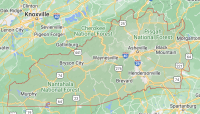Grant to help trout farm fish for new markets
Sunburst Trout Farms in Haywood County plans to add jobs and expand its operations thanks to a grant from the U.S. Department of Agriculture.
The farm received a nearly $300,000 Value Added Producers Grant from the USDA to help expand its market, namely finding new customers to buy more trout. The grant will help with everything from hiring a sales person to the upfront cost of trout fingerlings, which are then raised to full size at the farm.
Sunburst, founded by Richard Jennings, is a third generation family owned and operated company that processes fresh ready-to-cook and ready-to-eat trout products.
“The main goal is to stabilize things financially here,” said Sunburst’s Chef Charles Hudson. “We couldn’t have done it without that funding.”
The project, which will begin in April, will include purchasing more trout fingerlings, hiring new marketing and processing workers and installing new software to increase ordering efficiency. The plan is estimated to cost $500,000. The company was awarded $10,000 from the North Carolina Value-Added Cost Share Program in addition to the USDA grant.
Sunburst in particular hopes to increase business during winter months. The months of January, February and March are typically very slow for everyone in the mostly tourist-dependent region. The majority of Sunburst’s customers are within three hours of its Haywood County location.
But if the company is able to spread to new states, it could see more money rolling in throughout the year. One possible market is Florida, which gets a seasonal influx from people trying to escape the winter chill elsewhere.
“They (Florida) are busy when we are slow,” Hudson said.
Sunburst does not hatch its own trout from eggs but rather purchases them from trout hatcheries in Western North Carolina. The grant will allow them to increase the number of fish it purchases and therefore the number of trout it is able to sell.
Sunburst hopes to add about 100 new customers a year with the help of the grant funding.
To market the extra fish, Sunburst will also create a new marketing sales position. The job will include extensive travel and focus on expanding the company’s current market in the Southeastern U.S. Most of Sunbursts customers are restaurants, though their products are also available at some grocery stores.
Sunburst will add another two other positions to help carry the extra workload at its facility.
Last year, Sunburst sold about 250,000 pounds of trout. This year, it hopes to sell more than 300,000 pounds, Hudson said.
“It’s going to be a really good thing for not only us but for the county as a whole,” Hudson said.
Cherokee hits the big time: Top U.S. anglers to sample reservation waters
This little slice of Western North Carolina just landed the big one when it comes to competitive fly-fishing.
The 2011 U.S. National Fly Fishing Championship will be held this spring from May 19 to 22 in Cherokee. In addition to fishing in tribal waters, about 60 of the nation’s top fly-fishing experts will test their angling skills along nearby stretches of water: the Tuckasegee River below Western Carolina University, the upper and lower sections of the Nantahala River, and a to-be-determined area lake.
This marks the first time the competition has been held in the Southeast.
“It’s a really big deal,” said an unabashedly excited sounding Matt Pegg, executive director of the Cherokee Chamber of Commerce. “This events puts fishing in and around Cherokee on a national stage. It puts us up with the big boys.”
Not to mention the corresponding upward spending bump expected at area hotels, restaurants and shops. Hundreds of spectators from the U.S. and from other countries are expected to attend.
The anglers will be tested in a variety of water — low, high, fast, slow.
“We’re putting them in places where we know there’s great fishing, but they have to be skilled,” Pegg said. “And these guys are the best.”
If, for instance, a raft full of tourists paddles through, or a kayaker drifts by, the competition on the lower Nantahala, so be it, Pegg said. That’s fishing, and so goes on many days the experience of fishing that particular stretch of water.
The tournament organizers and hosts are the N.C. Fly Fishing Team, the Eastern Band of Cherokee Indians Fish and Wildlife Management Department and the Cherokee Chamber of Commerce, with River’s Edge Outfitters in Cherokee a supporter of the effort.
Cherokee is well known as a trout fishing destination, due in part to the stellar stocking of creeks and rivers by its own tribal hatchery. Robert Blankenship, director of the Cherokee fish hatchery and stocking operation, said putting Cherokee on the map as the best fishing destination in the Southeast has been their goal.
They raise and stock 400,000 trout, including trophy-sized, in 30 miles of stream. Compare that to the state of North Carolina, which puts 800,000 trout on 1,000 miles of stream.
“We are putting half that into only 30 miles,” Blankenship said.
Cherokee has gotten a great response from designating a 2.2-mile stretch of the Oconaluftee as catch-and-release, fly-fishing-only waters, a move that has lured new fishermen to the area.
Blankenship agreed it was quite a coup to land the tournament.
“It’s normally held in Vale, Colorado, or Jackson Hole, Wyoming, or somewhere out West,” Blankenship said.
Fishermen watching the nationals might decide to book their next fly-fishing trips here instead, further enforcing the region’s growing reputation.
“It will be good for Cherokee and the surrounding area and the local economy,” Blankenship said.
Another factor that puts WNC on the national fly-fishing map: fishermen from the western counties regularly dominate spots on the N.C. Fly Fishing team, and a couple of them usually go on to claim spots on the U.S. team each year. The tournament held here will determine who gets a spot on that coveted national team this year, said Paul Bourcq of Franklin, vice president of the N.C. Fly Fishing Team of Franklin. Those who make Team USA have a shot at the world team.
Bourcq is one of the big reasons the U.S. National Fly Fishing Championship is coming to WNC. He’s hosting the Southeastern Regional Qualifier for anglers this weekend (Feb. 19-20) with venues on the lower Nantahala, upper Nantahala and Queens Creek Lake in northwestern Macon County. Bourcq said this qualifier would serve to help polish organizational skills the sponsors need to pull off a great national championship competition.
Fly-fishing has long been a hotly competitive and avidly followed sport in Europe, and it enjoys a level of popularity there comparable to that of bass fishing in this nation.
“This will help make the Southeast a destination for fly fishing,” Bourcq said, who added that an angler is only as good as the water he fishes, and in WNC some of the best fly-fishing in the nation can be enjoyed.
Get involved
If you can read a ruler and measure a fish, then you have exactly the skills necessary to be a judge in the U.S. National Fly Fishing Championship, scheduled for May 19-22 in Cherokee.
Organizer Paul Bourcq needs judges, and lots of them — 60, to be exact, and he has only 20 signed up. This, he said, would be an excellent service project, perhaps for Boy Scout or Girl Scout troops. Grownups are welcome, too, of course. Contact This email address is being protected from spambots. You need JavaScript enabled to view it.; or through www.ncflyfishingteam.com.
Smokies fish expert, Steve Moore, earns national recognition
Great Smoky Mountains National Park Supervisory Fisheries Biologist Steve Moore was recently recognized with two national awards for his leadership in native trout stream restoration in the Smokies and at national parks across the nation.
Moore recently received the Aldo Starker Leopold Medal by the Wild Trout Symposium and the Trout Unlimited Trout Conservation Professional Award.
Both awards recognize the more than 25 years of achievement by Moore’s in restoring populations of native brook trout to streams in the Smokies, and assisting with other projects including the restoration of bull trout to Crater Lake National Park (Ore.) and to North Cascade National Park (Wash.) and restoring Bonneville cutthroat trout to Great Basin National Park (Nev.).
Throughout the country, a combination of habitat degradation and extensive stocking of non-native fish species have taken a heavy toll on numerous species of native trout, which typically require cold, clear, pristine water for survival. In many cases streams that may have been degraded by siltation or pollution have been cleaned up, but the native trout still need a helping hand to return.
According to Deputy Park Superintendent, Kevin FitzGerald, “One of the core missions of national parks is to preserve natural biodiversity which sometimes means restoring native plant and animal species which have been displaced from their historic homes by earlier human impacts,” said Deputy Park Superintendent Kevin FitzGerald.
In the Smokies, the brook trout was the only native species of trout, but they were crowded out of all but the most isolated high-elevation streams when — with the best of intentions —logging companies and early park managers released rainbow and later brown trout into Park streams in the early 20th Century.”
In the Smokies the brookies that remain in the headwaters face a double threat. They are squeezed between heavy competition from rainbows and browns downstream, and airborne acid deposition upstream that has made the water too acidic to support trout. The key to preserving the Appalachian brook trout is to remove the non-native trout from selected segments of lower-elevation streams and then to assist the brookies in moving downstream into less acidic waters.
To be suitable for restoration, a stream segment must have a record of a pure brook trout population in the past and a waterfall or other barrier at the lower end that prevents non-native fish from returning back upstream. Restoration of each segment involves removal of the non-natives through either electro-shocking and/or chemicals. Over the last 24 years of the Park’s Brook Trout Restoration Program, Park biologists — assisted by a small army of state fishery managers and volunteers from Trout Unlimited — have restored a total of 24.1 miles of stream to brook trout habitat.
Restoring each segment involves close coordination of 20 or more biologists and volunteers who string nets, electro-shock and relocate the non-natives, add and monitor the chemicals used and add neutralizing agents at the lower end of the segment being restored.
“Stream restoration is such a complex and labor-intensive process that the Park could never even attempt it without the financial support and/or hands-on assistance of all the neighboring entities such as Trout Unlimited, Tennessee Brookies, Friends of the Smokies, and the Tennessee and North Carolina Wildlife Resources Commissions.” FitzGerald said. “Steve has become nationally-recognized master of planning these restoration projects and brokering together a huge number of partners to get them done. We welcome this opportunity to acknowledge this well deserved recognition of Steve and show our appreciation to all the partners that he has brought into the mix over the years.”
Fish expert to deliver “State of the Trout”
Matt Kulp, fisheries biologist with Great Smoky Mountain National Park, will be speaking at 7 p.m. Monday, Sept. 20, at The Plateau Fly Fishing club meeting in Cashiers.
Kulp will discuss “What’s going on in the Great Smoky Mountain National Park — an aquatics and fisheries update including where to find the brook trout.”
A raffle will be held featuring various fly fishing accessories and an Orvis five weight fly rod.
The talk will be held the Albert Carlton Cashiers Library. Everyone is welcome. 828.885.7130.
Out like trout
Anybody who knows any thing about Western North Carolina is aware of the bountiful rivers and stream waters that paint an awesome landscape for trout fishing.
Urban and backcountry waters running in all directions makes the area an attractive mecca for fishermen from all over the country and certainly a treasure for Haywood County and the State of North Carolina.
According to Haywood County-bred and Waynesville native Roger Lowe, who has fished these waters for years, “We who live in this area know and have been raised here to know where the best spots to fish are on a daily basis.”
Lowe and his wife, Dianne, own and manage Lowe Guide Service in Waynesville. The couple often fish together and guide others to popular fishing spots in the area.
Each month people who come to Waynesville and Maggie Valley to fish, according to Lowe, most of them return the next season to fish again with several friends in tow.
Waynesville and Maggie Valley are enjoying the Mountain Heritage Trout Waters program in a cooperative effort between the N. C. Wildlife Resources Commissions and local governments to encourage trout fishing as a heritage tourism activity in Western North Carolina.
Maggie Valley — with the Trout Festival — hopes it can take advantage of this heritage designation. Residents and visitors who want to fish in a stream that is designated a Heritage Trout Water may purchase a 3-day license for $5. The license is designated only for waters in the recognized waters, and they are available at the Maggie Valley Visitor Center and at town hall. Visitors can use loaner fishing rods will be provided. Anglers under 18 must be accompanied by a guardian.
Park’s brookie population withstands drought well
By Jennifer Garlesky • Staff Writer
The Southern Appalachian brook trout population is surviving through the drought that has been plaguing Western North Carolina this past year, according to Great Smoky Mountain National Park fisheries biologists Matt Kulp.
Bill McLarney: Peeks Creek trout population wiped out
Local biologist and aquatic scientist Bill McLarney agreed with the Wildlife Commission’s revised recommendations to allow stream work, but for an unusual reason — the trout population, at least in Peeks Creek, is gone.





